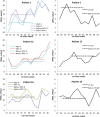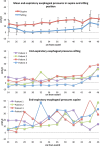Detailed measurements of oesophageal pressure during mechanical ventilation with an advanced high-resolution manometry catheter
- PMID: 31196203
- PMCID: PMC6567527
- DOI: 10.1186/s13054-019-2484-8
Detailed measurements of oesophageal pressure during mechanical ventilation with an advanced high-resolution manometry catheter
Abstract
Background: Oesophageal pressure (PES) is used for calculation of lung and chest wall mechanics and transpulmonary pressure during mechanical ventilation. Measurements performed with a balloon catheter are suggested as a basis for setting the ventilator; however, measurements are affected by several factors. High-resolution manometry (HRM) simultaneously measures pressures at every centimetre in the whole oesophagus and thereby provides extended information about oesophageal pressure. The aim of the present study was to evaluate the factors affecting oesophageal pressure using HRM.
Methods: Oesophageal pressure was measured using a high-resolution manometry catheter in 20 mechanically ventilated patients (15 in the ICU and 5 in the OR). Different PEEP levels and different sizes of tidal volume were applied while pressures were measured continuously. In 10 patients, oesophageal pressure was also measured using a conventional balloon catheter for comparison. A retrospective analysis of oesophageal pressure measured with HRM in supine and sitting positions in 17 awake spontaneously breathing patients is also included.
Results: HRM showed large variations in end-expiratory PES (PESEE) and tidal changes in PES (ΔPES) along the oesophagus. Mean intra-individual difference between the minimum and maximum end-expiratory oesophageal pressure (PESEE at baseline PEEP) and tidal variations in oesophageal pressure (ΔPES at tidal volume 6 ml/kg) recorded by HRM in the different sections of the oesophagus was 23.7 (7.9) cmH2O and 7.6 (3.9) cmH2O respectively. Oesophageal pressures were affected by tidal volume, level of PEEP, part of the oesophagus included and patient positioning. HRM identified simultaneous increases and decreases in PES within a majority of individual patients. Compared to sitting position, supine position increased PESEE (mean difference 12.3 cmH2O), pressure variation within individual patients and cardiac artefacts. The pressure measured with a balloon catheter did not correspond to the average pressure measured with HRM within the same part of the oesophagus.
Conclusions: The intra-individual variability in PESEE and ΔPES is substantial, and as a result, the balloon on the conventional catheter is affected by many different pressures along its length. Oesophageal pressures are not only affected by lung and chest wall mechanics but are a complex product of many factors, which is not obvious during conventional measurements. For correct calculations of transpulmonary pressure, factors influencing oesophageal pressures need to be known. HRM, which is available at many hospitals, can be used to increase the knowledge concerning these factors.
Trial registration: ClinicalTrials.gov, NCT02901158.
Keywords: Manometry (D008365); Mechanical ventilation (D012121); Oesophageal pressure; Oesophagus (D004947); Positive end-expiratory pressure; Respiratory mechanics (D015656).
Conflict of interest statement
The authors declare that they have no competing interests.
Figures




References
-
- Luciani L. Delle oscillazioni della pressione intratoracica intrabdominale. Studio sperimentale. Arch Sci Med. 1878;2:177–224.
-
- Buytendijk HJ. Oesophagusdruck em Longelasticiteit: University Groningen. 1949.
-
- Cherniack RM, Farhi LE, Armstrong BW, Proctor DF. A comparison of esophageal and intrapleural pressure in man. J Appl Physiol. 1955;8(2):203–211. - PubMed
-
- Frank NR, Mead J, Siebens AA, Storey CF. Measurements of pulmonary compliance in seventy healthy young adults. J Appl Physiol. 1956;9(1):38–42. - PubMed
MeSH terms
Associated data
Grants and funding
LinkOut - more resources
Full Text Sources
Medical

